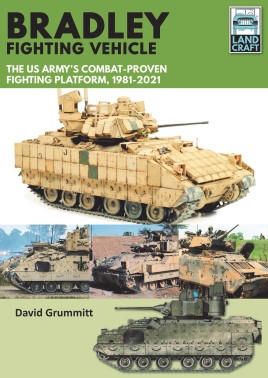Bradley Fighting Machine
Soft cover, 64 pages, Detailed color images..
From Wikipedia, the free encyclopedia
The Bradley Fighting Vehicle (BFV) is a tracked fighting vehicle platform of the United States manufactured by BAE Systems Land & Armaments, formerly United Defense. It was named after U.S. General Omar Bradley.
The Bradley is designed to transport infantry or scouts with armor protection, while providing covering fire to suppress enemy troops and armored vehicles. The several Bradley variants include the M2 Bradley infantry fighting vehicle and the M3 Bradley cavalry fighting vehicle. The M2 holds a crew of three (a commander, a gunner, and a driver) along with six fully equipped soldiers. The M3 mainly conducts scout missions and carries two scout troopers in addition to the regular crew of three, with space for additional BGM-71 TOW missiles.
The Author
David Grummitt is the editor of Military Modelcraft International with more than a decade of building models and writing articles for publication. As well as being editor of MMI since 2009, he is a professional historian who has written several books on fifteenth- and sixteenth-century military and political history.
The Illustrator
Slawomir Zajaczkowski writes books such as historical novels, comics, and magazines. A graduate of the University of Lodz, a comic book screenwriter known mainly from albums on historical and war topics, previously also a publicist, his articles about comics appeared in in the Comics Magazine "AQQ". He collaborated with several cartoonists, releasing albums in Andrzej Fonfara ("We remember: Biała Podlaska 1939-1945") and Artur Suchan ("One foot in the grave" screenplay together with Krzysztof Burdon).
Contents
- The Develoment of the Infantry Fighting Vehicle. The Germans were the pioneers in the development of the infantry fighting vehicle to support their concept of Blitzkreig as demonstrated in World War II. Small groups of German infantry were equipped with Schutzenpanzerwagen or armored fighting vehicles capable of keeping pace with tanks. Near the end of the war The US Army began looking into the infantry fighting vehicle leading to the ultimate development of the M113
- The Development of the Bradley Fighting Vehicle. In 1964 the US Army invited bids for the development of the new MICV-65 (Mechanical Infantry Combat Vehicle-65). This section goes into detail on the development of various vehicles conceived as fighting vehicles to meet these requirements. From the mid-1960's to the early 1980's several concepts were proposed, eventually evolving into the Bradley Fighting Vehicle.
- The Bradley Described. The Bradley Fighting Vehicle was first delivered to the United States Army in 1983. This section describes the development of variants and subsequent upgrades. A good deal of information, including several detailed color images are included.
- Camouflage and Markings. Here we have nine pages of color profiles of Bradley variants by Slawomir Zajaczkowski. Each profile includes a description of the vehicle, unit assignment and camouflage color, including FS numbers, which scale modelers should find quite useful.
- Model Showcase. This chapter includes thirteen pages of color images of various Bradley models in the popular scales. Models are by David Grummitt, Torsten Wagner, and Patrick Winepenninckx. The finished works are shown with several color images are quite inspirational and will be appreciated by the scale modeler.
- Modeling Products. In this section the author goes into great detail regarding model kits and the various accessories for Bradley models. Eight pages with color images cover this information. Again this material is very useful for the scale modeler.
- The Bradley Described (continued). see above.
- Other Bradley Variants. From the onset the Bradley was considered as a basis for other AFVs. The so-called Fighting Vehicle Systems Carrier (FVSC) eventually led to the Multiple Launch Rocket System (MLRS) along with several other concepts.
- The Future of the Bradley. The author discusses potential versions and upgrades of the Bradley Fighting Vehicles. The plan is to have a precise specification for a replacement vehicle by 2023.
- Bradley Walkaround. Three pages of images and text provide information and various details of the Bradley. Again, useful information for the scale modeler.
- The Bradley in Service. The Bradley was initially placed in service to Europe during the cold war. The author goes into detail regarding deployment. Operation Desert Storm is also covered along with service in Bosnia Kosovo and the Iraq War. The Bradley served well in these theaters with needed improvements identified and incorporated in later vehicles and retrofits.
- The Bradley Today. The deployment of the Bradley to Europe, South Korea, and Syria would show that this vehicle will remain in service in the future at the heart of the United States Army's warfighting capability.
- Further reading. The author offers a comprehensive list of additional publications on the Bradley Fighting Vehicle.
Conclusion
Overall, this was a very detailed and informative read. The author goes into detail in every section and offers a good deal of information on the design of the Bradley Fighting Vehicle, the necessary upgrades, features, deployments, combat actions and combat effectiveness of the vehicles.
I have wanted to build and add a Bradley to my collection for a long time. This book provided me with the incentive to do it. I very highly recommend this book to anyone having an interest in modern military vehicles. The color images included offer a good deal of detail that will be useful to the scale modeler,
Many thanks to Casemate Publications and IPMS/USA for the opportunity to review this publication. This book is well worth the money to add to the Scale Modeler's reference library.










Comments
Add new comment
This site is protected by reCAPTCHA and the Google Privacy Policy and Terms of Service apply.
Similar Reviews